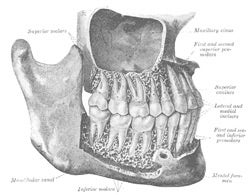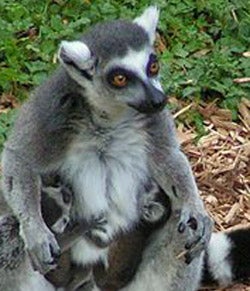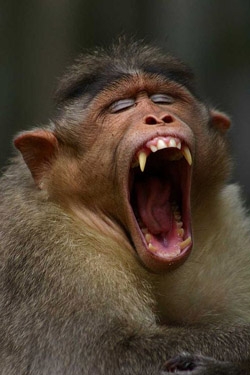Inside the primate skull
Your head is the most important part of your body. Your brain thinks, your mouth chews your food, your ears hear, and your eyes see. All of these important parts of your body are in your skull. So what about these body parts makes us human?
The human brain
Humans have larger brains than other primates. Thus, our skull is also larger. Our skull is also more globular (round like a sphere) than in other primates. Scientists think this spherical shape fits the most amount of brain tissue into the smallest amount of space. When we talk about brain size, it is important to consider brain size relative to body size. For example, would you expect an elephant’s brain to be larger than ours? Yes, elephants are much larger animals so they should also have a larger brain. Does this big elephant brain mean they are smarter than humans? No, elephants are not more intelligent than us. Our brains are bigger than you would expect given our body sizes, which means that our brains are relatively larger. Many scientists agree that relatively larger brains indicate greater brainpower.
When we talk about brain size, it is important to consider brain size relative to body size. For example, would you expect an elephant’s brain to be larger than ours? Yes, elephants are much larger animals so they should also have a larger brain. Does this big elephant brain mean they are smarter than humans? No, elephants are not more intelligent than us. Our brains are bigger than you would expect given our body sizes, which means that our brains are relatively larger. Many scientists agree that relatively larger brains indicate greater brainpower.
Human teeth
 Chewing is the main job of teeth. Without them, how could you chew a steak or bite into an apple? Primates are mammals, so we have the same four different kinds of teeth mammals do: molars, premolars, canines, and incisors. Human molars and premolars are rounded with nooks and crannies good for grinding down food while our incisors are wide and thin, perfect for cutting into food. Other primates have differently shaped teeth, likely because they eat different types of food. In primates, canines have evolved a second purpose. They are sharp and pointy and are excellent natural weapons. Most primates don’t use canines as weapons but yawning is seen as a threat gesture.
Chewing is the main job of teeth. Without them, how could you chew a steak or bite into an apple? Primates are mammals, so we have the same four different kinds of teeth mammals do: molars, premolars, canines, and incisors. Human molars and premolars are rounded with nooks and crannies good for grinding down food while our incisors are wide and thin, perfect for cutting into food. Other primates have differently shaped teeth, likely because they eat different types of food. In primates, canines have evolved a second purpose. They are sharp and pointy and are excellent natural weapons. Most primates don’t use canines as weapons but yawning is seen as a threat gesture.
Primate senses
 As for sight and smell, the ability of these sensory organs (eyes and nose) differs depending on the primate. Lemurs and lorises rely pretty heavily on smell. Because of this, they have longer snouts, which give them more pointed faces. Human, apes, and monkeys rely more on sight than smell. We have relatively larger eyes and flatter faces.
As for sight and smell, the ability of these sensory organs (eyes and nose) differs depending on the primate. Lemurs and lorises rely pretty heavily on smell. Because of this, they have longer snouts, which give them more pointed faces. Human, apes, and monkeys rely more on sight than smell. We have relatively larger eyes and flatter faces.
Look at those teeth! Primates such as this mandrill often yawn to show off their large canines. Typically, these guys yawn to threaten others, not because they’re tired.
Image by Steve Evans.









